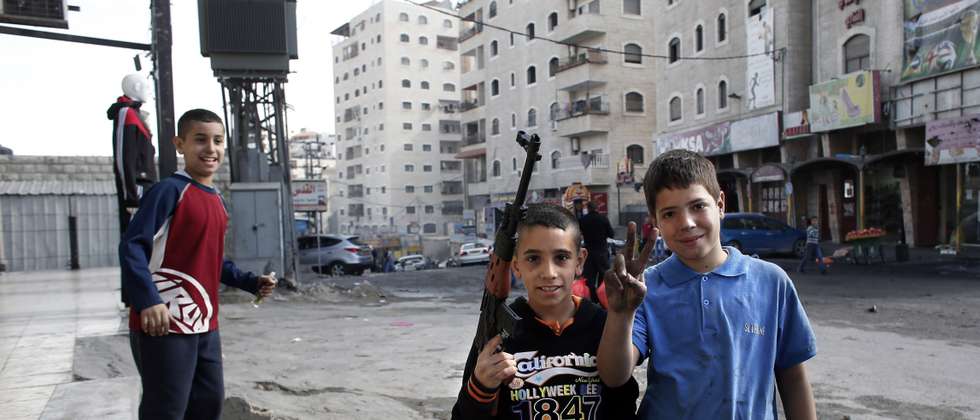The majority of Israelis have never entered the Palestinian neighborhoods, limiting themselves to the Jewish, western part of the capital & the Old City where Judaism’s holiest site, the Temple Mount & Kotel are.
By Ruti Sinai
The recent terrorist attacks in Jerusalem, carried out by residents of the city’s Palestinian neighborhoods, have placed an explosive issue on Israel’s public and political agenda: the extent to which the 28 Palestinian villages that Israel annexed to Jerusalem 47 years ago are a part of the city.

Palestinian boys with a toy gun in East Jerusalem neighborhood of Shuafat – Photo: AFP/Thomas Coex
The 1967 annexation was enshrined in a Basic Law, which enjoys special status and is a type of constitutional amendment. While not recognized internationally, the establishment of a united Jerusalem enjoys wide consensus in Israel.
Nonetheless, the vast majority of Israelis have never been to the Palestinian neighborhoods, limiting themselves to the Jewish, western part of the city and to the Old City where Judaism’s holiest site, the Western Wall of its biblical temple, is located.
Even Mayor Nir Barkat conceded on Friday that he had not been to those areas in a long time. “Barkat can go there, there’s no problem,” said Amir Cheshin, an adviser to Jerusalem mayors for over 20 years on the issue of the city’s one-third Arab population. “All we need is a division of border police and an armed personnel carrier,” he added, tongue in cheek, in a Friday night interview on Channel Two news.
The idea of cutting off the Palestinian neighborhoods from Jerusalem and placing them under the jurisdiction of a future Palestinian state in the West Bank has been broached in the past. Generally such calls have emanated from the center-left after terror attacks or reports about the dire social-economic problems that prevail in many of these areas, which bear the character of rural villages much more than of urban neighborhoods.
But such calls have generally been viewed as tantamount to advocating the division of Jerusalem, in other words – public heresy and political suicide.
In recent days, however, an indication of a shift on this position has emerged from an unexpected direction. “My grandfather in Europe prayed to Jerusalem and the Western Wall, not to Issawiyeh,” said Deputy Foreign Minister Tzachi Hanegbi, a Likud party legislator and close confidant of Prime Minister Benjamin Netanyahu, referring to one of the city’s Palestinian villages.
Asked by an interviewer whether he would insist on retaining all of East Jerusalem’s Arab neighborhoods, Hanegbi said: “In a permanent accord with the Palestinians, a creative solution can be found for the Arab neighborhoods.” A similar view was put forth in 2008 by another one-time Likud politician, Ehud Olmert, when he was prime minister.
Two events in the past week have drawn attention to the fact that on the ground, the city of Jerusalem is not as united as the rhetoric indicates. The first was a decision to place checkpoints and barricades at the entrances and exits from some of the Palestinian neighborhoods, impeding the free passage of their residents into other parts of the city.
The second was an order by Prime Minister Benjamin Netanyahu to examine options for stripping residents of East Jerusalem who carry out terrorist attacks or incite to terrorism of their residency permit.
Although they are not citizens of Israel, Arab residents of the city enjoy the same welfare benefits as citizens and have voting rights for the city council and mayor – rights to which most do not avail themselves as a political protest against Israel.
The problem posed by the city’s Arab population has bedeviled Israeli leaders for decades. In 1992, for example, the city’s legendary mayor Teddy Kollek wrote to then Prime Minister Yitzhak Rabin:
“The sum we received for dealing with the Arabs of Jerusalem will not enable us to do even the required minimum. This is essential in order to prove to one-third of the city’s residents that we are trying to equate their conditions to those of the others.”
But significant gaps remain in every aspect of the city’s 300,000 Arab residents – from sewage to housing, from education to transportation. “There is, of course, no justification for murder or terror, but people have to understand that the frustration is growing. They look out their windows and they see the state-of-the-art housing being built for Jews, and here they don’t have running water,” says Cheshin. “If we are serious about this being an integral part of sovereign Jerusalem, you cannot leave them in the 19th century.”
Barkat has another solution. The idea, he says, is “not to run away” but to bolster security in the city. President Reuven Rivlin also rejects ceding control over the Palestinian neighborhoods. “Jewish and Arab neighborhoods in Jerusalem are interlaced. We have passed the point of no return. We are now in a situation where we all live together. Building and dividing Jerusalem in an artificial manner will not help,” Rivlin said.
Ruti Sinai is a social and political commentator and an i24news editor.
View original i24news publication at: http://www.i24news.tv/en/news/israel/51989-141123-analysis-is-terrorism-dividing-jerusalem







 Israeli New Shekel Exchange Rate
Israeli New Shekel Exchange Rate